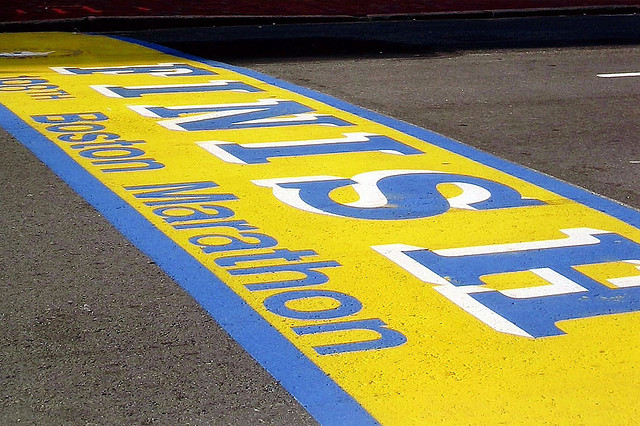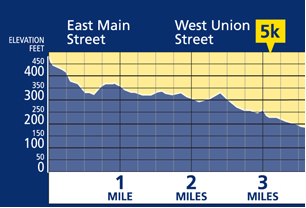In one week, tens of thousands of runners will line up in Hopkinton to run the world’s most prestigious race: the Boston Marathon.

Last year, I challenged all of you running Boston to make an important decision: settle or challenge yourself.
This year is no different.
You have two options:
- Get out of your comfort zone and push yourself to do something “impossible”
- Surrender to the discomfort of racing and settle for another “decent” race
If you’re like me, you prefer option #1. But understand than any great performance comes with a steep price: temporary pain and fatigue that feels crippling (even though it’s not).
It’s a fair price to compete in the world’s most prestigious marathon. You’ll be following in the footsteps (literally) of the best marathoners on Earth.
Runners like Meb Keflezighi (winner of the 2014 race), Patrick Makau, Lelisa Desisa, and Dathan Ritzenhein (who I interviewed here).
What other sporting event on the planet can you participate in where you’ll be on the same course as the pro’s?
None. You can’t shoot hoops on the same court as Lebron James. You can’t throw a touchdown pass on the same field as Peyton Manning.
Which is what makes distance running so special. In Hopkinton, you’ll be just a few hundred meters from the world’s best, starting at just about the same time, and running on the same course.
The same fans will cheer for you, just like they do for Olympians and previous Boston Marathon winners.
I have goosebumps just thinking about it.
Cherish this opportunity. For some of you, you may only have one chance to run Boston. Take every advantage you can to run the race of your life.
Start Slow (even MORE important at Boston)
Everyone knows that the Boston Marathon course is hilly. The most notorious hill in all of running – Heartbreak Hill – is aptly named because of where it comes on the race course: in the 21st mile after a series of equally punishing inclines.
And yes, these hills are difficult. But they get an unfair amount of attention because the biggest mistake most Boston marathoners make is starting too fast. And starting fast at Boston is particularly damaging because of the terrain.
What most runners don’t know (especially those running Boston for the first time) is that you’ll run one of the steepest downhills of the course in the first mile. Say goodbye to your quads if you run too fast!
Just look at this elevation profile of the first 3 miles (you can see the full course and elevation map here):

The first several miles at Boston are so incredibly easy to run fast that it’s difficult to slow down. I made this mistake myself in 2014 when my second mile was 5:41 (about 20 seconds faster than goal pace) and the third mile was 5:48.
I paid the price, ultimately slowing down in the final miles to my easy pace after a slew of other problems. Don’t let this happen to you! Pacing is more important than ever at the Boston Marathon.
It’s critical to run by feel during the early miles. Forget your pace band or attempting even splits at Boston – it’s virtually impossible.
Save your quads and start at goal pace, but preferably 5-10 seconds per mile slower.
Remember: The Boston Marathon isn’t won in the first 10 miles, but it can be lost! Tweet this out!
Prepare for the Weather
Most of us know that the weather at the Boston Marathon is notoriously variable. It can be freezing cold or a sauna, like the 2012 race.
No matter what happens on race day, prepare for the worst:
The weather currently is expected to be a good day with a low of 45 (your time in the Athlete’s Village before the race will be chilly!) and a high of 60 degrees.
This is similar to 2014. But don’t let a high temperature of 60 deceive you: it’s not optimal for marathons.
In Daniel’s Running Formula, the author points out that a 4 hour marathoner will lose 4 minutes to the heat if it’s 70 degrees. While it likely won’t be that warm on Marathon Monday, you could still lose 1-3 minutes depending on your heat acclimatization.
Since it takes about 7-10 days to adapt to the heat, you should already be doing some of your runs during the hottest part of the day. Don’t skip this part of training!
When I wrote about running in the heat, we learned the many efficiency gains you get from heat adaptation:
- Your body gets better at sending blood from your core to your skin, helping dissipate heat
- With all that blood rushing to your skin, your muscles now get less oxygenated blood. So to compensate, your body produces more (who needs blood doping?!)
- The body learns to control its core temperature and it won’t increase as much after you’ve acclimatized
- You start sweating sooner at a lower body temperature to improve the cooling process
- Sweat contains less salt so you maintain the right electrolyte balance
While Boston won’t be a scorcher this year, anybody who is not used to running in 55-60 degree weather (that could also be humid) should start running in the heat regularly this week.
Enjoy the Fans – But Focus on YOUR Boston Marathon
If you’re running to hit a time goal – or simply to maximize how good you feel on the day – then absorb the energy from the crowds and feed off the hundreds of thousands of cheering fans.
But don’t waste precious energy with high fives, waves, and kisses from the Wellesley College students that you’ll need to navigate the final downhill miles and the challenge of finishing strong on Boylston Street.
Sure, interacting with the crowd can be a great distraction (often, a necessary one).
But it can also be consuming.
In 2014, there were a record one million fans lining the race course. Every runner heard non-stop cheering and yelling for the entire race – HOURS of fan support that can feel draining, especially if you’re constantly engaging with these fans.
So retreat from the noise. Enjoy it, but don’t let it distract you. Prioritize YOUR race and your race only.
After all, running the Boston Marathon is a once in a lifetime opportunity for many of us. Focus.
Updated Boston Marathon Course Guide!
I’m excited to let you know that the Boston Course Guide has been updated for the 2015 race!
With edited text, new descriptions of the security process, and more applicable advice for this marathon, it’s your go-to guide to the Expo, Athlete’s Village, and marathon course.
The formatting has also been updated to make it easier to read with a lot of new pictures that make the Boston Marathon come alive.
You can learn more about it here.
I’ll leave you with wise words from the great George Sheehan:
Everyone who finishes the Boston Marathon has their own great moment in sport. Each of us on this day has achieved greatness.